Consumer Electronics Show 2005: AT's Coverage
by Anand Lal Shimpi on January 10, 2005 3:49 AM EST- Posted in
- Trade Shows
1080p DLPs Coming in April
Texas Instruments was quite eager to showcase all of the DLP based rear projection TVs that use their DLP chips.

Panasonic's 720p DLP
The most exciting thing at the TI booth however were the handful of displays that used TI's new xHD3 DLP - their first 1080p (1920 x 1080 progressive) DLP solution.

A 1080p image
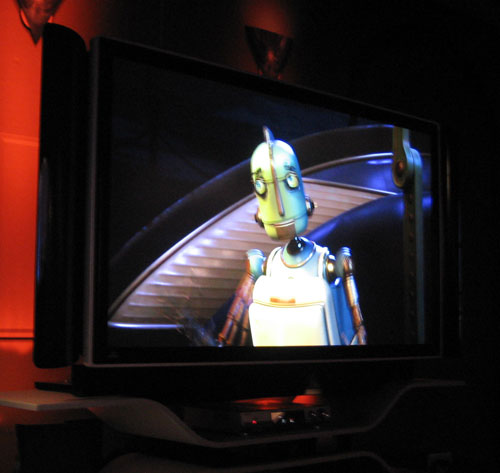
A 70" 1080p DLP
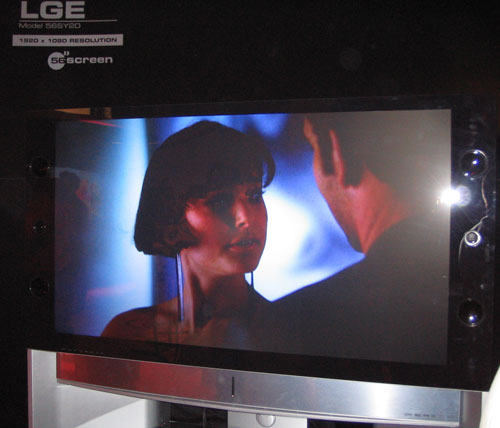
LGE's 1080p display
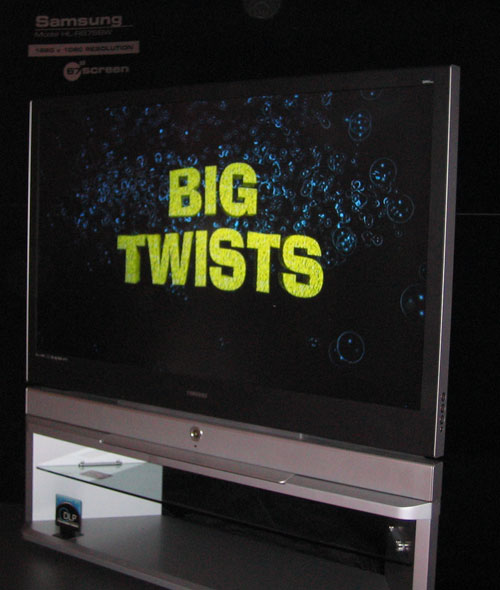
Samsung's 67" 1080p DLP priced at over $6000 and available in April
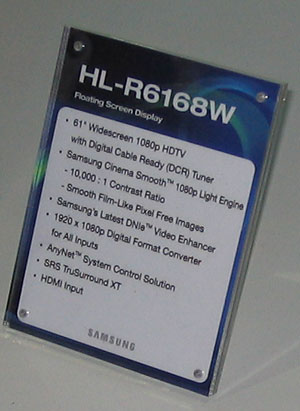
Samsung will also offer a 61" 1080p DLP
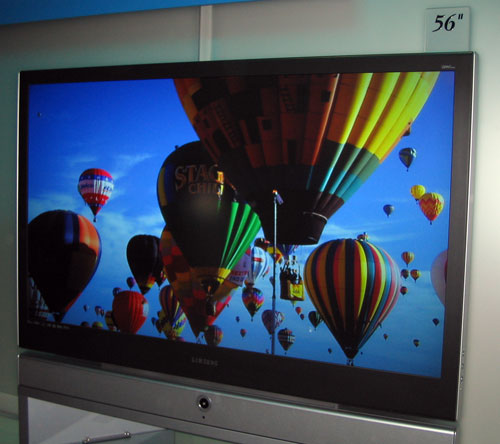
Samsung's 56" 1080p DLP also due out in April
TI also gave us a rundown of their current DLP lineup to clear up any confusion there may be over the cost/features of various TI solutions in DLPs today:
HD2 - TI's older DLP measures 0.8" diagonally and is a rectangular grid 720p DLP.
HD2+ - A higher contrast version of the HD2. The higher contrast was made possible through process improvements allowing for closer positioning of the individual mirrors, smaller mirrors and darker coatings to help absorb unwanted light inside the DLP.
HD3 - A 0.55" diagonal die not on a rectangular grid using half the mirrors of the HD2/HD2+ but still a 720p solution. Using mirrors that can move and stabilize at twice the speed of the HD2+ solution, TI was able to use each mirror for two pixels in the HD3 chip by shifting each individual mirror very slightly and very quickly to paint two pixels (think of it as a serial DDR approach to DLPs). The benefit of using half the mirrors is that it drives down the size of the DLP (0.55" vs. 0.8") and thus reduces the price of the TVs. The DLP also somewhat overlaps the two pixels it paints using a single mirror to get rid of pixelization, to provide for a smoother, more film-like image (which some may or may not prefer). TI calls this 2 pixels per mirror technology their Smooth Picture Technology, so whenever you see that phrase used it means that the TI DLP is only using half the necessary mirrors and using each mirror to drive 2 pixels.
xHD3 - A larger chip with a 0.85" die, the xHD3 is basically a HD3 that does 1080p. It also features Smooth Picture Technology.
Samsung displays based on the xHD3 DLP will be out in April, and available in sizes ranging from 56" up to 67".










48 Comments
View All Comments
quanta - Wednesday, January 12, 2005 - link
Isn't DLP design rather unreliable? After all, it involves mechanically moving millions of microscopic mirrors to create brightness, and there is no easy way to oil these tiny joints when the chip gets old. Since each mirror is moving thousand of times a second, dead pixels can develop rather quickly. As a side effect of moving all these mirror, won't the chips get noisy as well?PrinceGaz - Wednesday, January 12, 2005 - link
Heh, as soon as I read the bit about mobo manufacturers confirming what most of us already know; that nVidia has abandoned SoundStorm and it will not be returning in anything like its original form (DD encoding) in the forseeable future.Just because the Inq reports on something doesn't make it gospel truth, much of what they post is rumours and they have been known to be wrong in the past ;) As for the nVidia chairman saying SS is returning in a surprising form, that could mean just about anything except what some people here are hoping for. A return of the original SS or an updated version of it would be totally unsurprising so he is effectively ruling that out.
Could one of the SS zealots who believes it will make a return with PCIe please explain to me why it needs more bandwidth than what PCI can provide? Surely if the card is doing all the encoding, all that needs to be sent to it is the raw audio data which is minimal. Even the very highest quality 8-channel 32-bit 192khz sampling-rate uncompressed audio needs under 6MB/s of bandwidth which is easily handled by PCI, so I fail to understand why PCIe would make a difference. If there were sufficient consumer demand for a DD encoder, somebody would have already made one for PCI, so you're deluding yourself if you think the only reason they aren't available is that it needs the increased bandwidth offered by PCIe. Unless of course you have evidence which suggests otherwise and I'd be interested in reading it.
Rather than waiting for the return of SS, I suggest you buy a few decent cables and hook up your soundcard to your amplifier the normal way. Provided the soundcard has decent DACs, you'll enjoy higher quality sound than anything SoundStorm's dolby-digital output could provide.
linuxOwnzIfUrLeet - Tuesday, January 11, 2005 - link
#44,45...It's at sam's club:
It's made by infocus.
The web shows "InFocus® ScreenPlay 4805" but I'm not sure the 4805 was the one. Their web is not the same stuff as what you have in the store.
bob661 - Tuesday, January 11, 2005 - link
#44I was going to ask the same thing.
#39
SS is dead. Move on, nothing to see here.
OrSin - Tuesday, January 11, 2005 - link
14# Where can I get a 76 DLP for 1400.Shit where can I get decent 76" HD of any kind of for $1400. I live in the USA. I really want to know. My 42in Toshiba HD is not cutting it and it cost me $1000.
xxeper - Tuesday, January 11, 2005 - link
I love how you talk about how "bulky" the Windows Mobile [PocketPC, MPx] are while at the same time basically petting and licking the Windows Mobile smartphone [C500]. Did you even bother to pick up the BENq or iMat Jam phones? or were you too busy whispering sweet nothings to your P.O.S. Audiovox?Live - Tuesday, January 11, 2005 - link
#13The X800 you are linking to costs 450$ when its supposed to sell for 250$. and only that brand is available.
Zebo - Tuesday, January 11, 2005 - link
AMD was curiously quiet throughout the show,----------------
Speak Softly and carry a big stick.:)
RyanVM - Tuesday, January 11, 2005 - link
#9, I read the exact same thing in Maximum PC three months ago.shinotenshi - Monday, January 10, 2005 - link
The design team was disbanded, however many sources have already reported that the team was reconstitued. The design won't be finished by luck would have it, at the time the sony ps3 is done. As i said before, i don't this is a coincidence. the interest of sony(ps3,blu-ray) and nvidia(pushing pci-e, other markets, consumer, pci-e sound cards), are converging. If they can build a chip that can encode either DD++ or DTS+++ it would be an econnomic windfall.